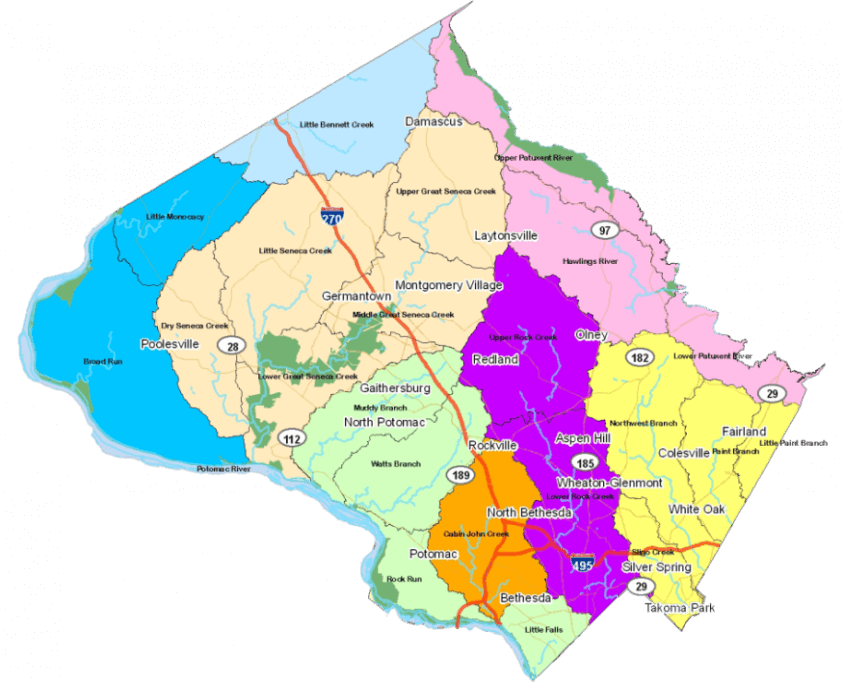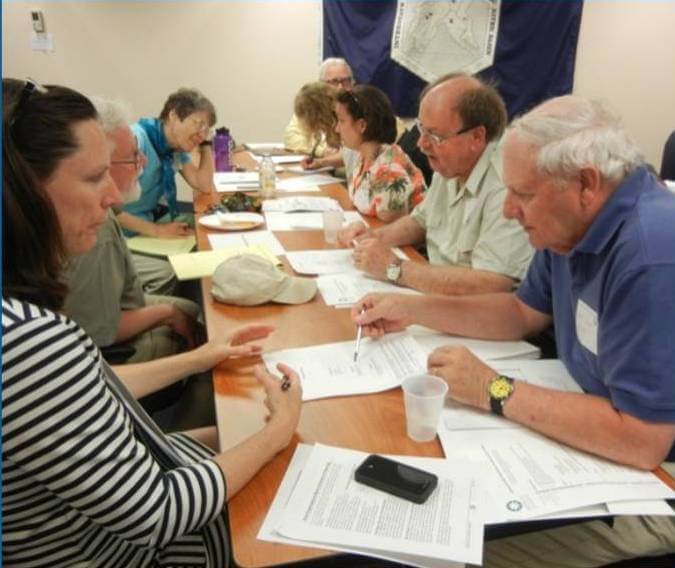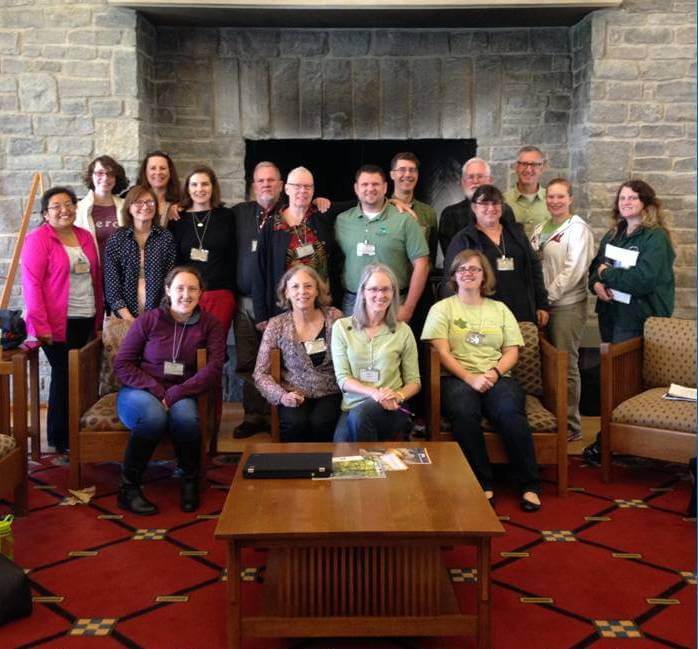Local Government and Watershed Organizations Partner for Water Quality Goals
Over the past 28 years, River Network has helped build and strengthen a national watershed protection movement that includes state, regional and local grassroots organizations whose primary mission is freshwater protection. Through our Strong Champions program, we work to have strong organizations advocate for clean water. By putting into place some key organizational best practices, organizations can become stronger in their work to fulfill their mission and realize their impact in the local community.
River Network recently concluded a unique two-year capacity building program in which a county government in Maryland supported the organizational growth of its local river and watershed organizations. The Montgomery County Department of Environmental Protection (DEP) contracted with River Network to help build the nonprofits’ organizational capacity so that they can become even stronger advocates for clean water in the county.
The County’s goal was to strengthen groups’ ability to assist the DEP in meeting its MS4 permit requirements to improve water quality. Meeting these requirements called for active community leaders to become involved and engage their peers in their respective communities. By supporting a capacity building program, DEP hoped to contribute to overall environmental behavior changes in the community. Ryan Zerbe, Outreach Program Coordinator for Montgomery County’s DEP explains that, “While the watershed groups in Montgomery County are all unique, many of them were struggling with common organizational issues.… The need for strong local watershed groups and healthy relationships with their local governments is essential for successful environmental outreach efforts”.
Partnership with Montgomery County DEP

A map of the different watersheds in Montgomery County, Maryland.
Though smaller in scale, the Montgomery County Capacity Building Program was based on the model of the watershed-wide Chesapeake Bay Capacity Building Initiative supported by the Chesapeake Bay Funders Network (CBFN). CBFN’s unique program was started in 2008, making organizational development a priority among Chesapeake Bay groups. It continues today with the start of the third phase of this 3-year initiative.
River Network’s Mary Ellen Olcese facilitated the capacity building program and offered group trainings and one-on-one customized assistance over a two-year period (2014-2016) to the eight participating watershed groups in the county: Neighbors of Northwest Branch, Friends of Sligo Creek, Muddy Branch Alliance, Watts Branch Alliance, Rock Creek Conservancy, Friends of Cabin John Creek, Little Falls Watershed Alliance, and Seneca Creek Watershed Partnership. All of these organizations are located in Montgomery County, Maryland, in the northern DC suburbs. The groups were at different organizational levels – from newly formed organizations to those with active, functioning boards and clear mission statements. While a few groups had paid staff, most were all-volunteer organizations.
“Despite the fact that we all were watershed groups, we were in different places. Some were brand new; others were well funded; and some of us have been around long enough to have lots of systems/committees/practices and tended to be more set in our ways,” said Kit Gage, President of Friends of Sligo Creek.
This unique Capacity Building Program prioritized the issues that were most important to growing the organizations’ capacity, emphasizing “best organizational practices” and benchmarks. Workshops and consultations were designed to enhance the groups’ abilities to implement and measure the success of programs that assist Montgomery County in meeting its MS4 permit requirements. Particular attention was given to:
- Strategic planning;
- Board development issues (e.g. board recruitment and orientation, term limits, succession planning, and committee structure);
- Volunteer management; and
- Additional topics selected by the groups (e.g. membership recruitment and management, financial management, databases and annual workplans).
The Program
This Capacity Building Program consisted of three parts – 1) Assessment; 2) Trainings; and 3) Peer-to-Peer Learning. Each group was asked to provide information on 13 capacity building indicators at the program’s start and end. Using this information, they identified their most pressing organizational issues.
Trainings consisted of in-person sessions, webinars, one-on-one customized assistance and regional forums. The trainings focused primarily on strategic planning, expanding outreach, recruiting and managing volunteers and developing board structures and policies.

A training session in progress. Photo credit: Ryan Zerbe
Personalized, one-on-one assistance was a major emphasis of the program. River Network staff planned customized training and mentoring sessions that addressed each group’s particular challenges and was designed to have specific outcomes. Mary Ellen met with leaders from each group, engaged all attendees in the topics, and built consensus among/between Board members and staff in any areas of disagreement. At the conclusion of each customized session, each group had a list of recommendations and next steps, as well as benchmarks to help them track their progress.
Participating groups had the opportunity to attend River Network’s organizational development webinars to meet their interests and needs. Groups also came together for peer- to-peer learning and networking through two informal “roundtables”. These gatherings allowed the groups’ leaders to express common challenges and share possible solutions and success stories. These roundtables alternated with the whole group sessions described above, allowing the groups to meet in person quarterly. As a result of the program, participating groups have developed planning documents and implemented structures and policies, and are now realizing more effective operations. A few examples of these results are:
- Seneca Creek Watershed Partnership has a new strategic plan from which it gauges its annual work plan.
- Little Falls Watershed Alliance is recruiting Board members through a new deliberative process that assesses skills needed for the organization.
- Friends of Sligo Creek is planning for the succession of its officers and determining term limits for its Board members.
At the conclusion of the program Ryan Zerbe of DEP recalled that, “… the groups received countless tools and strategies to not only identify their strengths and common pitfalls but also bring that awareness into action with proper strategic planning and organizational development training. Today, I am proud to say that a clear uptick in grassroots watershed organizations has been observed in Montgomery County since the capacity building program began. Not only that, but the program has assisted in improving communications and collaboration within and amongst the existing organizations, including a strengthened relationship with our department.”

A gathering of the Montgomery County watershed groups at one of the Roundtable sessions. Photo credit: Ryan Zerbe
Quotes from Participating Organizations
Staff of Rock Creek Conservancy said, “The [program]…allowed us to share our successes and learn from our challenges. This kind of interaction is key to the successful protection of water and land in Montgomery County, allowing a community to come together to protect our valuable natural resources. As an organization with such a large scope, volunteers play an integral part in helping us achieve our mission of protecting the lands and waters of Rock Creek. The [program] assisted us in better understanding volunteer management, enabling us to more successfully recruit and retain those who contribute to our efforts.”
Ann Smith of Seneca Creek Watershed Partnership recalled, “When River Network started consulting… we were able to write our first strategic plan, finish our 501(c) 3 paperwork, with a conflict of interest form, and submit our bylaws to the State. Mostly, what River Network taught us was the parts about running a business that our active stream group wasn’t interested in… As we met more frequently with different numbers of board directors, and members, we began to see the fairness involved with a proper organizational base. With the introduction of the webinar series, we were able to apply the foundations for a solid board of directors.”
Tina Rouse of the Friends of Cabin John Creek described her organization as “a small-but-growing watershed group…River Network’s advice and support came at an opportune time. The capacity building materials were essential tools in defining our future path and developing a plan for strategic growth, and Mary Ellen Olcese’s personal guidance helped to focus our efforts and resources where they had the most impact. Learning from others in the local watershed community at the roundtable events was an added bonus, and we know that the relationships we developed in the program will continue to be valuable resources.”




